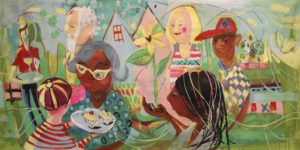
Anticipating new investment in the Monon 16 neighborhood in Indianapolis, neighbors and artists got together to create a vision for their community. Like residents in many mid-size cities, they welcome new businesses and more housing filling in the vacant lots at this intersection of the Monon Trail and 16th Street, but worry about the impact of development on the cost-of-living and culture of their place.
With leadership and support from a neighborhood arts organization, the Harrison Center, artists from thirteen theatre companies spent a year with residents developing Pre-Enact Indianapolis—a day of theatre, music, art-making, and art selling to show the region what they want their neighborhood to be in the future.
In the time between the initial planning for this event and the date of the shows on the sidewalk, vacant lots, and transformed buildings, a lot changed in the three-block commercial district on 16th Street. On performance day, there was a coffee shop, taco place, and shiny apartments for rent—all new. The Monon Lofts are designed to be affordable—still, these neighborhood assets are classic signals of potential for future displacement. Joanna Taft, the executive director of the Arts Center, and the neighbors in the area, had correctly anticipated these changes.
One of the shows, developed by the partnership between residents and artists, played out on the sidewalk where a stage set of three small row houses sat in front of real, boarded-up tiny homes. The play, produced by Asante Children’s Theatre of Indianapolis, was mostly the story of three young girls, one from each of the three houses, and their friends.
At the end of the show, the action flashed forward to present day and the three girls became adults reuniting. One remained a resident of the house she grew up in, one had rented her house and was living elsewhere, and the third had moved away and sold her house. The seller was lamenting her choice to sell, as the value of the house is now going up. The landlord was considering selling, since her house is now worth more and the taxes are increasing. The remaining resident was worried that her taxes would go up so much that she’d be forced to sell. All of them were pleased with the changes in the area—they especially liked the new taco place. The remaining resident described plans of a city council member to get a law passed that will reduce the real estate taxes of long-time residents precisely so that they aren’t priced out by positive changes in the neighborhood.
As a theater lover who spends a lot of time on issues of gentrification and displacement, I thought to myself: Well, this is different and very cool—a play about POLICY! Of course, I thought it was an innovative way to share knowledge and build a coalition to advocate for equitable development.
But it turned out to be more than that.
An hour or so later, in one of the vacant lots, musicians and spoken word artists entertained, as we sat under the trees eating treats from the food entrepreneurs lining the side street, while kids played basketball nearby on a pop-up court. In mid-afternoon, a Congressman (a real one) took the stage to congratulate the residents and organizers. He was followed by a City Council member (a real one) who announced that he is promoting legislation to reduce real estate taxes for residents of neighborhoods like this one. The policy wasn’t just an idea promoted by residents in a play they created to envision the future they want—it’s real too.
Councilman Vop Osili spent time explaining how rapidly property values are increasing in some places and how that impacts residents, especially those on a fixed retirement income. He talked about the value of retaining long-time residents in the places where they’ve invested and created a vibrant life, even as others left their homes and businesses, and local government looked the other way. The culture of a place is enriched by its history and the people who’ve created it over time, he said. That’s worth investing in by forgoing some taxes so that people can stay, he concluded. Then he asked the audience to tell him what they thought about this idea, to raise questions and share suggestions for promoting this legislation.
Wow. The artists and residents designed this platform for explanation and advocacy and change. They didn’t just pre-enact their future; they made space for action and coalition building.
Pre-Enact Indianapolis is creative placemaking—when artists and designers partner with residents in place-based community planning and development—the real deal.

Leave a Reply